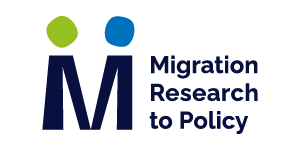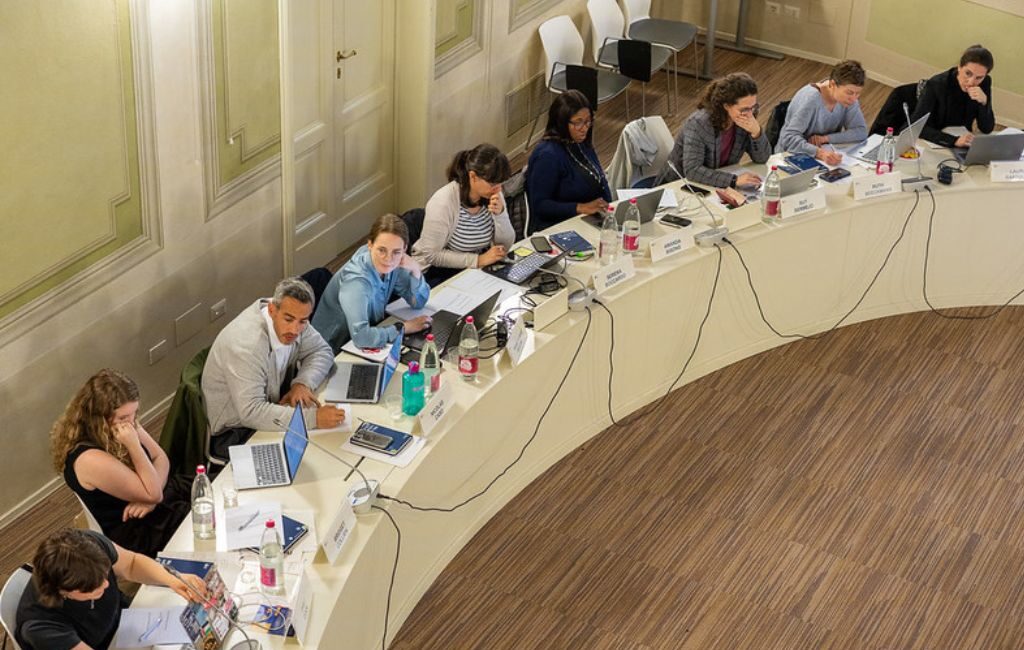Engagement hub
How can research be useful, practical, and applicable? We're here to help.

Good Practices Toolkit
Discover practical approaches for bridging migration research and policy.
This toolkit, created by researchers for researchers, offers recommendations for integrating evidence into decision-making and engaging with policymakers. These suggestions stem from the best practices of consortium partners, serving as models and inspiration.
1 Understand your audience
Mapping and identification of relevant stakeholders
- Acknowledge the diversity of migration policymakers and include government agencies at the national, regional and local levels, EU institutions, and international organisations.
- Map out the policymakers pertinent to the research topic, as well as civil society and private sector actors (see 4. Stakeholder engagement for policy change).
- Conduct a stakeholder analysis to assess the power, interests, priorities, and influence of the identified key players in the field.
- Continue to map the policymaking environment throughout the research cycle to take into account newly emerging actors and loss of relevance of others.
- Recognise the potential role of volunteers, grassroots practitioners and local administrators in indirectly influencing high-level national policymakers.
Understanding of the policy context
- Take into account that policymakers operate in complex environments balancing security, human rights, and economic interests.
- Get to know the political and practical environment policymakers work in, and how these factors influence their priorities and receptiveness to the research.
- Closely monitor the political climate and current policy debates to understand stakeholders’ stances and how research might align with – or challenge – political narratives and priorities.
- Be aware that policymakers may be more open to research during periods when they are seeking new solutions, while they may be less receptive in times of political gridlock or high pressure in other policy areas.
- Familiarise yourself with the institutional priorities and dynamics of the responsible authorities.
- Engage with both high-level policymakers and grassroots practitioners for a comprehensive understanding of the context of migration and integration policies.
Good Practices
Identify key stakeholders, map policy networks, and use strategic engagement to ensure your research reaches the right policymakers.

2. Building relationships and trust
Engaging early and often
- Aim for continuous engagement with policymakers through direct outreach and networking – one-off interactions have limited impact.
- Leverage existing events and networks to establish initial contact and build visibility.
- Use research interviews or consultations as opportunities to initiate engagement with policymakers.
- Include policymakers in events as active participants and speakers rather than passive recipients.
Developing mutual respect
- Approach policymakers with respect, showing a willingness to learn from their expertise and share your own.
- Meet on equal footing, avoiding any hierarchical or condescending attitudes.
- Demonstrate empathy for the pressures and constraints faced by policymakers.
Informal engagements
- Maintain regular communication with policymakers through newsletters, direct outreach, and personalised engagement.
- Leverage informal settings (e.g., training sessions, conferences, and networking events) to gradually build the relationship.
- Create informal feedback channels (e.g., email updates or short surveys) to maintain continuous exchange.
- Organise site visits or hands-on demonstrations to showcase practical implications of your research.
Towards long-term engagement
- Treat relationships as long-term investments, ensuring consistency in communication.
- Build bridges between projects to maintain continuity and sustain engagement.
- Encourage co-creation of outputs (e.g., jointly developed policy recommendations) to foster shared ownership.
- Engage and develop long-term collaborations also with lower-level policymakers and civil servants who remain in roles longer and influence policy continuity over time.
Addressing changes among policymakers
- Stay abreast of personnel changes among policymakers and ensure relationships are continued with new actors.
- Create a contact database to retain institutional memory.
- Provide “handover briefs” to newly appointed policymakers summarising past collaboration and future opportunities.
Remaining relevant
- Keep research aligned with current and emerging policy challenges to stay on the policymaker’s radar.
- Actively disseminate findings even after project completion to maintain visibility.
- Participate in policy-relevant events and contribute to ongoing discussions to demonstrate continued relevance.
Good practices
Foster trust with policymakers, create reciprocal partnerships, and establish yourself as a go-to expert in migration policy.

3. Tailoring research to policymakers’ needs
Principles for crafting policy-relevant research
- Ensure research questions match policymakers’ needs, accurately reflect the field and are relevant to practice.
- Align research with policy priorities and consider policy dynamics, political actors, and constraints to ensure relevance.
- Identify topics aligned with the evolving agenda of policymakers, focusing on areas likely to remain relevant for years.
- Identify and address policy gaps to help policymakers recognise where current policies fall short and how research can inform improvements.
- To ensure credibility, maintain scientific rigor, academic independence and transparency once the research questions are established.
Engaging to develop research questions
- Engage with policymakers and practitioners in the inception phase to understand what they need from the research.
- Organise in-person meetings with policymakers to ask direct questions such as: Do you need us to change the focus? Are there gaps we should consider?
- In meetings, ask policymakers about their specific bottlenecks, to be able to tailor research (and later, recommendations) accordingly.
- Refine research questions based on this early engagement while preserving academic integrity.
- Identify whether research uptake is intended for direct policy change, conceptual understanding, or political justification.
- Host pre-project workshops or webinars to introduce research ideas and gather input from other policy stakeholders.
Fostering co-ownership
- Use early engagement with policymakers to establish ownership and increase the likelihood of application.
- Allow policymakers and stakeholders to feel they contributed to the research and are co-owner of results, rendering uptake more likely.
- Highlight how research can be beneficial for internal policy capacity-building and agenda-setting, even if immediate policy change is not the goal.
- Maintain long-term collaborations with policymakers to enhance knowledge continuity and impact.
Research approach and designs
- Use prior research and policy documents as additional sources to ensure alignment with priorities of policymakers.
- Balance scope and focus to ensure research questions are broad enough for systemic understanding, yet specific enough for actionable insights.
- Use comparative research designs, highlighting best practices from different countries to allow policymakers to recognise gaps without directly pointing out deficiencies.
Good practices
Align your research with policy priorities, frame actionable questions, and enhance the real-world impact of your findings.

4. Stakeholder engagement for policy change
Including policy stakeholders in engagement
- Take into account that a range of policy stakeholders play a role in influencing policymaking and include them in your research-to-policy engagement.
- Aim to provide these policy stakeholders with tailored knowledge tools for promoting evidence-based policies.
- Identify the relevant policy stakeholders by extending your power mapping beyond policymakers, to include civil society actors, social partners, service providers, the business sector, international organisations, and other research actors.
- Make a special effort to include migrant-led organisations and initiatives, to empower them for participatory policymaking and advocacy for more legitimate and effective policies.
- Identify potential allies among the policy stakeholders who can help bridge gaps between research and policymaking.
- Consider that local-level actors provide valuable insights and expertise but lack direct influence; and that science-backed validation can amplify their concerns.
- Identify the policy stakeholders early andassess their interests, concerns, level of influence, and their stance on policy issues.
Methods of stakeholder engagement
- Employ research and process designs which ensure continuous participation, leading to co-creation of research questions and policy recommendations.
- Offer interactive formats such as consultation workshops, focus groups and collaborative sessions for meaningful and inclusive discussions.
- Apply deliberative methods and encourage structured dialogues (such as policy labs and roundtables) where different perspectives on possible policy solutions are considered.
- Apply user-centered methodologies, such as design thinking, to develop practical and innovative policy solutions.
- Organise dedicated discussions where stakeholders contribute to shaping and refining recommendations, to ensure they are practical.
- Use impact assessments to track stakeholder engagement, citation of reports, and real-world policy adoption influenced by stakeholder input in order to adjust engagement strategies and improve effectiveness.
Factors of success when involving policy stakeholders
- Ensure representation of affected communities, particularly migrants, refugees, and marginalised groups, throughout the engagement process.
- Establish advisory groups, comprising both diverse policy stakeholders and policymakers, to provide ongoing feedback and guidance.
- Use informal networking and relationship-building to gain stakeholders’ trust.
- Keep stakeholder events small (20 participants as upper limit) for meaningful discussions.
- Use digital tools to increase participation in stakeholder dialogue and collaboration, such as (multilingual) online platforms, virtual roundtables, online surveys, and webinars.
- Work through established policy forums and advocacy networks; and align with ongoing political discussions and legislative cycles to amplify impact.
- Highlight stakeholder roles and clarify how each actor – policymakers, policy stakeholders, researchers – can contribute to policy implementation.
Ethical considerations in engagement
- Ensure fair representation and that diverse voices are heard, avoiding tokenism and self-selection bias in stakeholder representation.
- Design engagement processes that are accessible to vulnerable groups, including migrants and refugees.
- Implement ethical safeguards to respect anonymity and to prevent retraumatisation when working with displaced individuals and refugees.
- Maintain confidentiality and obtain informed consent when collecting personal narratives or case studies.
- Be transparent and accountable, by ensuring stakeholders’ contributions are acknowledged and used meaningfully.
- Clearly communicate how stakeholder contributions are used in collaborative research and policy development.
- Provide feedback mechanisms to ensure stakeholders are informed of outcomes and next steps.
Good practices
Use strategic engagement, coalition-building, and evidence-based advocacy to influence policy decisions effectively.

5. Reaching policymakers: Content and messages
Communication style, accessibility and non-partisan stance
- Use accessible, clear language that conveys complex findings effectively and minimise jargon for clear, engaging communication.
- Provide concise and actionable messages, as policymakers favour short and direct communication.
- Keep recommendations brief and to the point for policymakers who have limited time.
- Avoid overloading reports with excessive detail – summarise key points in bullet form.
- Present findings in a neutral, fact-based manner that allows policymakers to engage constructively.
- Remain objective and factual, avoiding political bias that could erode trust.
- Acknowledge multiple perspectives and demonstrate sensitivity to contentious issues.
- Frame research findings in policy-relevant language and align them with ongoing political debates.
- Always adjust language and presentation to the audience’s expertise.
Crafting problem-oriented and actionable policy recommendations
- Prioritise strategic recommendations in the most impactful areas, rather than overwhelming policymakers by listing everything that needs improvement.
- Balance feasibility and ambition, by offering solutions that can be realistically implemented while setting the stage for future reforms.
- Focus on most critical recommendations that can serve as a stepping stone for broader policy revisions and systemic change.
- Present solutions as gradual improvements toward a larger vision rather than isolated fixes.
- Suggest improvements to current structures or expansion of existing initiatives when calling for entirely new policies is not realistic.
- Consider feasibility within existing constraints, by taking into account budget limitations and current policy realities.
- Include easy-to-implement solutions (“low-hanging fruits”) that policymakers can act on quickly without requiring major structural changes.
Bringing up policy gaps and shortcomings
- Frame recommendations positively as enhancements rather than criticisms to increase receptiveness.
- Avoid accusatory language to maintain constructive dialogue. Rather than stating that something is lacking, frame findings as areas where improvement can build on existing strengths.
- Present findings in a way that allows policymakers to see patterns and trends without feeling directly targeted.
- Use comparative overviews and best practices to illustrate trends, rather than explicitly stating gaps.
- Acknowledge policymakers’ sensitivities and that governments may be concerned about their country’s image, and frame findings accordingly.
Discussing policy recommendations
- Allow policymakers to draw conclusions themselves and to take the initiative in addressing gaps.
- Share case studies or success stories that resonate with policymakers’ goals and experiences.
- Engage policymakers in discussions about how recommendations align with their responsibilities and constraints.
- Use storytelling techniques and real-life examples to make policy recommendations more relatable and memorable for policymakers.
Building capacity for policy implementation
- Encourage policymakers to envision long-term policy impacts by linking past trends with future projections.
- Use real-world policy scenarios and hypothetical situations to encourage strategic policymaking and help stakeholders think beyond immediate concerns.
- Provide policymakers with structured decision-making choices (e.g., “If you take action X, scenario Y happens”).
Good practices
Craft compelling, problem-oriented policy recommendations that resonate with decision-makers and drive meaningful change.

6. Reaching policymakers: Timing, tools and channels
Strategic timing of research dissemination
- Plan report launches around key political events or legislative windows to ensure visibility and increased relevance.
- Plan Align research dissemination with ongoing political debates to maximize impact.
- Use policy-relevant hooks (e.g., a scheduled legislative debate) to secure attention and meetings with policymakers.
- Aim for ongoing engagement with stakeholders rather than one-off dissemination.
Targeted and impactful dissemination
- Revert to power mapping techniques to identify the decision-makers and policy stakeholders to be targeted in strategic dissemination.
- Customise engagement strategies and adapt communications based on policymakers’ specific interests, priorities, past policy positions and professional background.
- Individualise engagement with direct outreach, tailored messaging, and strategic networking.
- Use a multi-channel approach to research dissemination, including social media, direct emails, policy notes, personal briefings, stakeholder events, and webinars.
- Offer policymakers interactive formats for direct engagement an, and d closed-door discussions, such as informal meetings, Q&A sessions, simulations, policy labs.
Tailored communication tools
- Present findings in digestible formats, such as key messages, executive summaries, and storytelling.
- Keep your material simple and reduced to core messages, while making it holistic and contextualised at the same time.
- Develop concise one-page policy notes summarising key findings.
- Create visually engaging and accessible materials, such as infographic-based presentations, to highlight key policy recommendations.
- Convert research into blogs, podcasts, infographics, and videos to reach different audiences.
- Repurpose presentations, reports, and events into multiple content formats to maximise exposure.
Using digital and traditional media for impact
- Social media targeting – customise dissemination strategies for different platforms (to reach professionals, for advocacy, for visual storytelling).
- Use infographics, short videos, and reels to communicate research findings on social media.
- Engage traditional media through op-eds, journalist engagement, and concise press releases, and participate in media panels to amplify research findings.
Follow-up strategies
- Reinforce engagement post-launch through targeted meetings and continuous outreach.
- Use meetings and events as opportunities to follow up, share further materials, and arrange next steps.
- Send concise follow-up emails summarising key points and suggested actions.
- Provide periodic updates on progress and invite feedback to maintain engagement.
Good practices
Master strategic dissemination, leverage key policy moments, and use the best tools to maximise policy engagement.

Resources
Tips and techniques to maximise the impact of research
Submit your idea for a 750-word post to be featured on our Engagement Hub.























